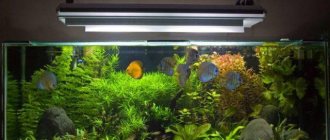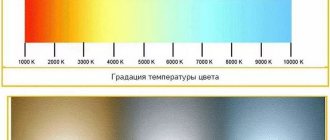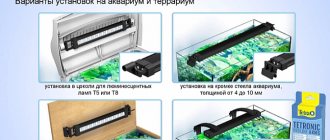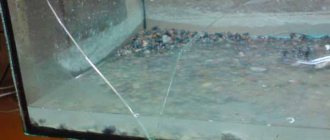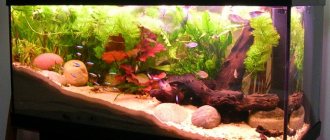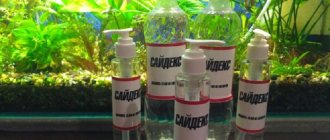The right lamp for a marine aquarium is the home sun for the ecosystem you have created. Without quality lighting, your colony of corals, algae, plants and the inhabitants living among them will feel extremely unwell. The correct system of day and night, as well as a sufficient amount of ultraviolet light, is necessary for absolutely every representative of the biotope. Insufficient lighting intensity will very quickly lead to a decrease in the growth of underwater plants and corals, and will also significantly reduce the beauty of your aquarium. Without proper nutrition, corals will stop producing the colors they are truly capable of, and the design you come up with will look much less expressive.
What are MG lamps?
Metal-halogen lamps are included in the group of gas-discharge lamps. In such lamps, gas glows due to its ionization using electric current. Inside the flask there are metal halides and mercury vapor, and it is in this mixture that the glow actually occurs. In terms of light output per 1 Watt of energy consumed, MGs are superior to all other known types of lamps. Metal halogen lamps should not be confused with halogen lamps. The latter are not gas-discharge lamps, but belong to incandescent lamps.
Comparison table of the best aquarium lamps
| Name | Main characteristics | Price |
| Jebo 8W T5 | In an oblong-shaped body, it is made in three different colors: white, blue and red - for different types of aquariums with different inhabitants. | ₽ 545 |
| Aquatlantis Lighting fixtures T5 | Designed for aquariums of the 150 series from Evasion Horizon, installed in classic lamps from the Portuguese company Aquatlantis. | ₽ 24 339 |
| Xilong T8 10W XL-50B | Designed for a lamp with one lamp, which is installed above the aquarium without a cover, equipped with a reflector and protected by plexiglass from splashes. | ₽ 1 430 |
| T8 15W 43.8cm Sylvania GROLUX | Designed for freshwater aquariums, if there are plants living there that do not have enough daylight, you can illuminate greenhouse or indoor plants with this lamp, for example. | ₽ 530 |
| BLV RX7S 150W 5200K | With a power of 150 watts for the RX7S base, it produces bright daylight white light with a color temperature of 5200 Kelvin. | ₽ 600 |
| BLV HIT 250W cw 10000K | With a power of as much as 250 watts, designed for large professional aquariums, there is a built-in aluminum-coated reflector. | ₽ 4 069 |
| ADVANCE 40, AQUA TRESOR | It shines brightly and hardly heats up, is characterized by high luminous efficiency and efficiency, lamp power varies from 2.4 to 10 watts. | ₽ 3 116 |
| LEDDY SMART LED II SUNNY 6W | Attaches to the wall of an aquarium up to 6 millimeters thick and is perfect for small aquariums ranging from 10-50 liters and no higher than 35 centimeters. | ₽ 2 001 |
Lighting an aquarium with MG lamps - advantages.
The MG lamp is a very bright and efficient point light source. Unlike fluorescent lighting, spot lighting, using bright sunlight-like light, gives an indescribable picture in the aquarium. Spot light allows you to experience the underwater space in its natural form. The impression is as if you are looking into the water column on a bright sunny day. Shadows from objects, plants, fish are visible. Even the ripples on the water play with penumbra at the bottom of the aquarium. The effect of lighting with a metal halogen lamp is really close to what we can observe in sunny weather in a natural pond. This lighting clearly seems more natural to the fish as well. And since when this light source is turned on, its brightness increases gradually as the halide vapors inside its bulb heat up, fish are less susceptible to stress when the light is turned on.
Another important aspect is that the light rays enter the water at an angle that is close to 90˚, which makes it possible to use live plants in aquariums over 50 centimeters deep. The properties of metal halide spot light are close to that of the sun, and the vast majority of plants feel just great under it.
MG light sources have a fairly long service life. Throughout the entire period, light output close to the original one is maintained. This means that the lamp does not need to be changed during its entire service life.
The efficiency of metal halogen lamps is higher than that of fluorescent lamps, and significantly exceeds that of incandescent lamps. They spend up to 24% of the energy consumed to produce light energy.
MGL (DRI) for lighting in an apartment or workplace, basics and selection + review of 35W lamps
I want to tell you about the “weakest,” well, almost the weakest MGL lamp available on the market. It is better to choose lamps of “standard power”; they are (almost) always available in (online) stores - 35/70/150 W (the rest is “exotic” - there may be problems with electronic ballasts and/or lamps).
Honest color rendering index CRI >80(warm) / >90(cool). All human-visible colors 380-780 nm are present . Approximate brightness of lamps (varies slightly by brand, DH, measurement methods): 35W ~3400lm, 70W ~6800lm, 150W ~14000lm .
We choose lamps from the brands Osram/Philips/GE abbreviation (HCI/CDM/CMH) form factor (T/TC) ceramic burner only .
T – G12 socket (on the left) - in fact, G8.5 is glued into another socket, TC – G8.5 socket, they are not compatible with cartridges from ordinary halogen lamps; you don’t have to try to fit in something that cannot be squeezed in, the only option is to invent it “with your own hands” ( for example terminal blocks) because I couldn’t find lamp sockets on the open market without buying a lamp. Lamps for them produce directional light, which is not needed in everyday life. Ceiling “pancakes” (glass and metal) and “ball” lamps with halogen lamps are well suited for remodeling.
Important information : I was never able to find out this information from any seller, I was only able to find in an old printed booklet from Philips what the difference is between almost identical lamps. Although I roughly guessed about this, watching how they were launched.
There are two types of lamps for use only with electronic ballasts and “universal” ones with electromagnetic or electronic ballasts. They differ in the presence of a spark gap, (on the right) for “universal” ones. The only disadvantage of “universal” ones when used with electronic ballasts is a hissing sound for 1-2 seconds (during high-voltage “ignition”) when turned on/restarted.
The lamps are connected to the network via ballasts:
- There are electromagnetic ones (throttle + IZU ignition system + capacitor) - I don’t consider them in the article - the lamps on them flicker, have a lower luminous flux, fail faster, and the extra 2-3 kg on the chandelier does not add optimism.
- and electronic ballasts - I consider only those from well-known brands that are easy to find on sale from Osram/Philips (they are interchangeable). Important: the wire from the electronic ballast to the lamp should not be more than 1.5 meters — I did 2 and it worked fine (I think the manufacturers are playing it safe).
- Electronic ballasts are quite complex; they use a microcontroller to monitor the operation of the lamp (Osram PTI is built on an osram 209-657 microcontroller and an osram 2115107 microcircuit). Electronic ballasts will turn off the faulty lamp, if the voltage is exceeded, they will go into protection, and will not “finish off” a hot lamp by constantly restarting, etc. And most importantly, they give a relatively soft start, but sometimes it can fail - for example, a contact falls off while starting the lamp (the heaviest mode for it) and the bulb will be “filled” with mercury, residual salts and other “substances”. The lamp, of course, will “come to life” and clean itself later, but it will take noticeably longer to flare up and “stabilize in colors” ~ 5-7 minutes.
That's how she was unlucky, this is what a lamp looks like that has survived its life for > 20,000 hours, they shine confidently only in the ir range, and in terms of the brightness of visible light they are more like a night light 
Osram electronic ballast size 35/70/150W (with open housing) (Philips are approximately the same). For comparison of sizes - hygienic lipstick.
Everything is fine with cosf 0.95 Robiton PM3 - showed PF = 100
As I said in the last article, the MGL does not start immediately, but after 1 minute it gains 70% brightness and by 2 minutes the light and 100% brightness are stabilized (the full startup cycle was filmed)
These lamps cannot be restarted immediately after being turned off. But there are 2 options to solve this problem:
- connect 2 lamps in parallel - one will start, randomly - the second will remain cold and start when the light is switched.
- “hot” restart, requires not 5000 volts, as with a normal start, but 50,000 volts and greatly reduces the life of the lamp - used in “autoxenon” - yes - there is an (almost) ordinary 35W MGL with only a quartz burner (cheaper (outdated) technology).
What happens if you turn off the lamp and turn it back on again?
Then I waited 5 minutes (the lamps cool down for 7-15 minutes depending on the power)
Why is it better to choose non-elite lamps, look at the spectrum - the “regular” one (top picture) is smoother, and the colors of objects under the elite lamp are more similar to an advertising clip for a Samsung TV. I cited for the “cold” 942, they have more “peaks” “It’s clear that the “warm” ones have a similar story. Although, again, it’s a matter of taste, maybe someone likes brighter colors...
cited for the “cold” 942, they have more “peaks” “It’s clear that the “warm” ones have a similar story. Although, again, it’s a matter of taste, maybe someone likes brighter colors...
A little about datasheets for lamps and beautiful and not so beautiful numbers.
One nuance needs to be taken into account: Philips measures indicators for electromagnetic ballast, while Osram measures indicators for electronic ballast (see screenshot from the datasheet)
I also found an interesting point that I had never seen with LEDs...
Additional material
Catalog from Philips
Datasheets for Philips lamps
Datasheets for Osram lamps
Datasheets for Osram electronic ballasts
Photo of an Osram HCI TC 35W lamp (round burner) and a Philips CDM TC 35W lamp, from personal observation - I like Philips better, they have a “more stable” color flux over an output of more than 5000 hours.
PS fierce “collective farm” to remake an office lamp
Disadvantages of lighting with MG lamps.
Metal-halogen lamps also have a number of disadvantages. First of all, this is their high temperature. All the power is concentrated at one point and therefore the lamp itself and the surrounding space are heated to a significant temperature. The temperature outside can reach more than 200˚C. This state of affairs requires a special approach to installing the lamp. It is necessary to ensure protection against even the slightest drops of water getting on the flask, because this can lead to its explosion. If the lamp is installed in the lid of the aquarium, it must be covered with protective glass. In addition, it is necessary to consider a heat removal system. It is best to use small but powerful enough fans.
Another disadvantage of MGs is their sensitivity to vibration and power outages. Both the first and second (even a short-term power failure) can cause the lamp to go out.
Some types of lamps require only vertical installation, others only horizontal, there are also universal ones, for which the position in space does not matter. In aquarium farming, universal and horizontally mounted lamps are more often used.
Lamps operate in a wide range of light ranges. This means that their radiation also contains ultraviolet rays. Therefore, it is necessary to use protective glass of sufficient thickness. It should protect not only underwater inhabitants, but also the eyes of the observer from ultraviolet radiation. For these purposes, ordinary silicate glass is suitable. It is known to significantly inhibit the flow of ultraviolet rays.
Top 8 Best Aquarium Lamps
Best Metal Halide Fluorescent Bulbs for Aquarium
BLV HIT 250W cw 10000K
These lamps are for advanced aquarists. Their cost is from 4000 rubles. For this money you will get a lamp with a power of as much as 250 watts, designed for large professional aquariums. The lamp has an aluminum-coated reflector built into it: thanks to it, the light from the lamp is distributed evenly, and the lamp does not heat the environment too much. This lamp is quite easy to change - it is mounted on an E40 socket. The manufacturer promises continuous operation for up to 8000 hours.
Price: RUB 4,069
BLV RX7S 150W 5200K
Lamp BLV RX7S 150W 5200K - costs from 600 rubles. 150 watt gas discharge lamp for RX7S socket. Consistently produces bright daylight white light with a color temperature of 5200 Kelvin, which will remain unchanged throughout the life of the lamp. Durable, energy efficient, resistant to temperature changes. Does not have a destructive effect on plastic and dyed fabrics.
Price: ₽ 600
Best T5 Fluorescent Tubes
Aquatlantis Lighting fixtures T5
Fluorescent lamp for fish Aquatlantis T5 lighting fixtures for Evasion Horizon 150 aquariums. It will serve as a backlight for a long time. Designed for 150 series aquariums from Evasion Horizon, but can be used with other aquariums of a similar configuration. Installed in classic lamps from the Portuguese company Aquatlantis: with long metal bodies that are attached to plastic mounts directly on the walls or aquarium lids. This lamp is characterized by high quality, efficiency and long service life.
Price: RUB 24,339
Jebo 8W T5
Jebo aquarium lamp white 8W T5 costing from 550 rubles. Reliable lamp in an oblong shaped body. Made in three different colors: white, blue and red - for different types of aquariums with different inhabitants. The high luminous efficiency and long service life of this lamp are confirmed by the observations of numerous fans. There are also higher power versions: 10, 15, 20, 25, 30 and 40 watts.
Price: ₽ 545
Best LED Aquarium Lights
ADVANCE 40, AQUA TRESOR
The LED lamp, which shines brightly and hardly heats up, is characterized by high luminous efficiency and efficiency. A universal device that will suit any aquarium and will promote the growth of fish and photosynthesis of plants. Does not affect the quality of water in the aquarium and is completely safe for its inhabitants. The power of the lamps varies from 2.4 to 10 watts - you can choose the one that suits the size of your aquarium. The cost of the model starts from 3000 rubles.
Price: RUB 3,116
LEDDY SMART LED II SUNNY 6W
This aquarium lighting module is somewhat cheaper - it costs around 2000 rubles. The lamp is attached to the wall of an aquarium up to 6 millimeters thick and is perfect for small aquariums in the range of 10-50 liters and no higher than 35 centimeters. Able to work for about 10 years without any difficulties - all thanks to cold and economical LEDs housed in a thin and even elegant body. The color tends to be warm - the color temperature is 6500 Kelvin. Provides fish and plants with the necessary light and emphasizes their natural beauty.
Price: ₽ 2,001
Best T8 Fluorescent Tubes
Xilong Lamp T8 10W XL-50B
Fluorescent lamp for fish Xilong Lamp T8 10W XL-50B costs about 1,500 rubles. Designed for a lamp with one lamp, which is installed above an aquarium without a cover. The length of the aquarium should not exceed 50 centimeters: within this limit, the width of the lamp mounts can be adjusted. The lamp is equipped with a reflector and protected from splashes by plexiglass, looks stylish, and is also equipped with an additional socket - you can connect other aquarium equipment. Lamp power 10 W.
Price: ₽ 1,430
T8 15W 43.8cm Sylvania GROLUX
Aquarium lamp T8 15W 43.8cm Sylvania GROLUX costing from 500 rubles. This fluorescent lamp is designed for freshwater aquariums where there are plants that do not get enough daylight. Plants require photosynthesis to grow and develop, and to facilitate this process, the spectrum of the lamp is shifted towards blue and red radiation. Moreover, in the light of this lamp, plants and fish will not only grow better and feel good, but also look much better, because it emphasizes their natural colors. This lamp can illuminate not only aquariums, but also, for example, greenhouse or indoor plants.
Price: ₽ 530
How to arrange lighting for an aquarium with MG lamps.
With all the advantages and disadvantages of metal halide lamps, arranging lighting for an aquarium with their help requires careful thought and competent execution of what was planned.
Metal halides are best installed on a suspended fixture or bracket. With this installation, the aquarium is deprived of a lid in its classical sense. The light sources installed in the lamp are suspended either from the ceiling or on a special bracket above the aquarium. This way the aquarium remains open and this has a number of advantages. You can do various work inside the aquarium without turning off the lamp. The plants and the arrangement itself can be allowed to spread upward outside the aquarium.
If you are a fan of a classic aquarium with a lid, you will have to make a fairly high lid to install metal halides. Lamps should be located at least 20 cm from the water. It will be necessary to install cooling fans in the lid, since the temperature of the lamps is quite high and if this is not done, they will heat not only the lid itself, but also the water in the aquarium. In addition, it is necessary to provide protective glass. If water gets on a heated glass flask during operation, it will inevitably lead to an explosion.
Calculations when choosing a lamp
As mentioned earlier, the decisive indicator when choosing a backlight is the power of the light sources. It would seem that the more powerful, the better? Not everything is so simple... In order for your fish and plants to feel comfortable in the aquarium, that is, light, warm and cozy, you will have to think and make some calculations. They will help us figure out which lamp to give preference to.
Lumens and Luxes
For our calculations we will need terms such as Lumen and Lux. The first unit shows the amount of light given by a particular light source, and the second shows the illumination depending on the area:
- for averagely populated aquariums, the indicator generally used is 50 Lm per 1 liter of aquarium.
- if the aquarium is densely planted, then this figure increases to 60 lm per 1 liter.
- Well, if you have a lot of free space, then 40 Lm per 1 liter is enough.
Of course, there are subtleties. For example, the design of some lamps does not allow directing all the radiation to the aquarium and part of the light flux is inevitably scattered. For example, LED lamps emit light at an angle of 120 degrees. We have to take this into account and make adjustments.
You can also calculate the required illumination depending not on the liters of the container, but on its area. The illumination of 1 square meter with light of 1 Lumen will be equal to 1 Lux. If we use Lux as a calculation indicator, then for a standard aquarium, that is, one whose width is greater than its height, then the indicators will be as follows:
- for not too demanding plants, 6000-10000 lux is required
- for light-loving plants you need from 10,000 to 15,000 lux
Also, do not forget that water can reflect light. And such losses can be about 40% if the aquarium is open. To try to reduce these losses, you can cover the aquarium with a white lid. We also remember that with depth, plants receive less light. We also make appropriate corrections for depth.
Installation of lamps with MG lamps.
With all the variety of metal-halogen lamps, perhaps the best option can be considered double-ended, which are used in street lighting floodlights. They are designed for installation in a horizontal position in a special cartridge. However, installing the lamp itself is quite a painstaking task, but if you take a ready-made spotlight, then installing everything is much easier. For installation, you will need a bracket on which the spotlight will actually be mounted.
The use of a ready-made spotlight is justified for several reasons:
- Firstly, the spotlight has a reflector that is designed for the type of lamp used and perfectly concentrates its light.
- Secondly, the spotlight is balanced in terms of heat transfer and has a protective glass that protects the lamp from moisture.
- Thirdly, if we buy separately a lamp, an electronic ballast for it, adjust the reflector for its maximum efficiency, cut out the protective glass, and so on, then as a result we will get some semblance of the same spotlight, but at the same time we will waste time and gain almost nothing in money.
How to choose a lamp for a marine aquarium?
If you have not yet decided which lamp to buy for a marine aquarium, then pay attention to the shape of the selected tank. Cubic and angular models will most likely require much lower power equipment than the popular elongated version. Some lamps allow you to use several lamps at once.
For your complete safety, as well as the protection of the inhabitants of the colony, never remove the glass cover placed on the lamp itself to protect the lamp from accidental exposure to water. This could result in the lamp exploding, which should never be allowed to happen. It is required to maintain complete tightness.
Using a timer.
When using metal halogen lamps, the use of a timer is justified. Lamps will be more durable if you give them the opportunity to turn off for about an hour in the middle of daylight. The timer will help you remember to perform this action every day. As for the inhabitants of the aquarium, such a blackout for some time will not cause any negative consequences. In nature, the sun is also periodically covered by clouds and the illumination drops.
Map of site.
TOP
The most popular question about aquarium lamps
How to choose the right lamps for an aquarium? In the old fashioned way, many aquarists calculate the amount of light based on the power of the lamps used. Since time immemorial, the norm has been considered to be 0.5 watts per 1 liter. Of course, only a small number of slow-growing plants will do well under such lighting. For aquariums with a large number of plants with long stems, the wattage rating increases to 1 watt per liter. This calculation method can now be used for ordinary incandescent lamps. It can also be used with T8 and T5 fluorescent lamps.
Don't forget about the length of daylight hours. When plants and animals are in their natural environment, in a body of water, its duration is approximately 8 to 12 hours a day. It is important to maintain approximately the same lighting regime so that the inhabitants of the aquarium are not stressed and feel comfortable.
